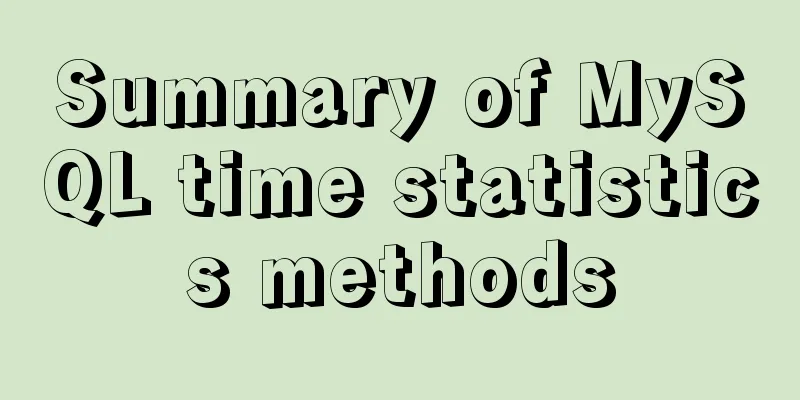A brief discussion on the lock range of MySQL next-key lock

PrefaceOne day, I was suddenly asked about MySQL's next-key lock, and my immediate reaction was:
What the hell is this? ? ?
I can't see anything in this screenshot? Looking closely, it seems familiar. Isn't this the content in "MySQL 45 Lectures"? What is next-key lock
The official website's explanation roughly means: the next-key lock is a combination of a record lock on the index record and a gap lock on the gap before the index record. Give yourself a bunch of little question marks first? ? ?
Since I don’t understand anything, I have to start from the beginning and practice! Let’s first look at the conclusion of Mr. Ding Qi in “MySQL 45 Lectures”:
After reading this conclusion, most of the questions should be answered, but there is one very important sentence that needs attention: Therefore, the above rules may not be applicable to the current version. Below I will take Environment PreparationMySQL version: 8.0.25 Isolation level: Repeatable read (RR) Storage engine: InnoDB mysql> select @@global.transaction_isolation,@@transaction_isolation\G mysql> show create table t\G
To learn how to install MySQL using Docker, refer to another article: Install and connect to MySQL using Docker. Primary key indexFirst, let's verify the range of the next-key lock of the primary key index.
The database data at this time is shown in the figure. For the primary key index, the data gap is as follows:
Primary key equal value query - data exists mysql> begin; select * from t where id = 10 for update; This SQL statement locks You can view the lock information through # mysql> select * from performance_schema.data_locks; mysql> select * from performance_schema.data_locks\G For specific field meanings, please refer to the official documentation
The results mainly include information such as engines, libraries, and tables. We need to focus on the following fields:
The result is obvious. Here, an IX lock is added to the table and an Similarly, It can be concluded that: When locking the primary key value and the value exists, an intention lock is added to the table and a row lock is added to the primary key index. Primary key equal value query - data does not existmysql> select * from t where id = 11 for update; If the data does not exist, what lock will be added? What is the scope of the lock? Before verification, analyze the gaps in the data.
Use data_locks to analyze the lock information:
Look at the lock information
At this time, when executing SQL in another Session, the answer is obvious: id = 12 cannot be inserted, but id = 15 can be updated. It can be concluded that when the data does not exist, the primary key equal value query will lock the gap where the primary key query condition is located. Primary key range query (key point)mysql> begin; select * from t where id >= 10 and id < 11 for update; According to the analysis of "MySQL 45 Lectures", the following results are obtained:
First look at data_locks
You can see that in addition to the table lock, there is also a row lock ( So in fact id = 15 can be updated. That is to say, there is a problem
The result verification is also correct, id = 12 is blocked for insertion, and id = 15 is updated successfully. What if the right side of the range contains an equal value query? mysql> begin; select * from t where id > 10 and id <= 15 for update; Let's analyze this SQL: Also take a look at data_locks
It can be seen that only one X lock is added for the primary key index id = 15. Verify that id = 15 can be updated? Verify again whether id = 16 can be inserted?
It turns out there is no problem! Of course, some friends here will say that there is a bug in "MySQL 45 Lectures" that will lock the next next-key.
It turns out that this bug has been fixed. The fixed version is Reference link address: https://dev.mysql.com/doc/relnotes/mysql/8.0/en/news-8-0-18.html Search keywords: Bug #29508068)
We can reproduce it with 8.0.17 respectively:
In 8.0.17, Let's take a look at the question of whether it is
Now I estimate that it is very likely that when Compare data_locks data:
Note the red underlined part. In version 8.0.17, when SummarizeThis article mainly verifies the next-key lock range when locking the primary key through actual operations, and consults materials and compares versions to draw different conclusions. Conclusion 1:
After optimization, it opens later. I don’t know whether this is because after optimization, the primary key interval will be opened directly later, or because it is a bug. Specific friends can try it. Conclusion 2 By using
The next-key lock range of the primary key has been basically understood. Note that the version used is 8.0.25. doubt
The article is limited in length, so you can think about it for yourself first and try it out yourself. Practice makes perfect. As for the specific answer, the next article will be needed to verify and summarize the conclusion. This is the end of this article about MySQL next-key lock locking range. For more information about MySQL next-key lock locking range, please search 123WORDPRESS.COM's previous articles or continue to browse the following related articles. I hope you will support 123WORDPRESS.COM in the future! You may also be interested in:
|
<<: Solution to the problem of z-index not taking effect in CSS3
>>: A brief discussion on Flink's fault-tolerant mechanism: job execution and daemon
Recommend
User needs lead to marketing-oriented design
<br />For each of our topics, the team will ...
Control the light switch with js
Use js to control the light switch for your refer...
Docker Compose installation and usage steps
Table of contents 1. What is Docker Compose? 2. D...
Vue multi-page configuration details
Table of contents 1. The difference between multi...
td content automatically wraps table table td after setting the width too much text automatically wraps
Set the table's style="table-layout:fixed...
Detailed explanation of Nginx static service configuration (root and alias instructions)
Static files Nginx is known for its high performa...
Detailed explanation of the use of Join in Mysql
In the previous chapters, we have learned how to ...
HTML table tag tutorial (35): cross-column attribute COLSPAN
In a complex table structure, some cells span mul...
Detailed example of clearing tablespace fragmentation in MySQL
Detailed example of clearing tablespace fragmenta...
Detailed explanation of table_open_cache parameter optimization and reasonable configuration under MySQL 5.6
1. Introduction table_cache is a very important M...
How to distinguish MySQL's innodb_flush_log_at_trx_commit and sync_binlog
The two parameters innodb_flush_log_at_trx_commit...
Analysis of JavaScript's event loop mechanism
Table of contents Preface: 1. Reasons for the eve...
MySQL replication table details and example code
MySQL replication table detailed explanation If w...
Detailed explanation of the process of building an MQTT server using Docker
1. Pull the image docker pull registry.cn-hangzho...
Using jQuery to implement the carousel effect
This article shares the specific code for impleme...




























